With last night’s Game 5 victory over the New York Rangers, the LA Kings were crowned champions of the 2013-14 NHL playoffs. After their most recent triumph, the Kings have gone from having a Cinderella cup run in 2010-11 to being talked about as the next dynasty, along with the Blackhawks. They did it by going through a gauntlet in the Western Conference, which included the San Jose Sharks, Anaheim Ducks, and Chicago Blackhawks. Despite the fact that the Kings proved to be one of the most resilient teams in recent history, they did receive some help along the way, from their opponents.
If your team doesn’t win the cup, fingers are going to be pointed and blame assigned. Sometimes it’s justified, other times it isn’t. For the following players, the blame is definitely deserved.
Rick Nash & Brad Richards
In his time in Columbus, Nash played in just one playoff series and played well, scoring 3 points in 4 games. When he came to the Rangers, fans exclaimed they were excited to finally see Nash on a contender that would regularly make the NHL playoffs. Now, those fans are eating their words. After six series in a Rangers uniform in the playoffs, a judgement about Nash’s postseason game can be made, and it’s not good.
In 37 playoff games for the Rangers, Nash has mustered up just 4 goals and 11 assists for 15 points. That gives Nash a career playoff points-per-game of .44, a far cry from his .80 PPG in the regular season. The most frustrating part about Nash in the playoffs is that it does not appear that he is making a conscious effort to fix his game.
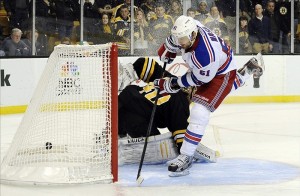
It’s very clear what he needs to do. He needs to use his size and speed to drive the net and play like a true power forward. Instead, he has remained passive and has preferred to operate on the perimeter. The fact that he led the playoffs in shots with 83, but had just 3 goals, shows that he was unwilling to go to the dirty areas to score. Instead, he settled for low percentage perimeter shots that will not beat goalies like Jonathan Quick or Carey Price. Rangers fans have soured on Nash so much that some want him bought out. While he has been quite the disappointment, a buyout is not the correct move.
Nash, 29, certainly has been a disappointment relative to his $7.8M cap hit, but four more years at that number for Nash is more palatable than Brad Richards, 34, at $6.667 for six more years.
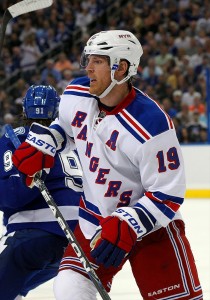
Richards deserves a fair share of blame for the Rangers’ elimination as well. In these playoffs, he managed 5 goals and 7 assists for 12 points in 25 games. Richards was so ineffective these playoffs that he was demoted to the fourth line in Game 4, the only game the Rangers won, coincidentally. If there is a lock for a team to use their compliance buyout on a player, it’s Richards and the Rangers. The Rangers face significant cap recapture penalties if he retires before the 2019-20 season, the last on his contract. Combined with his ineffective play, and the fact that he will only get worse, it’s a no brainer.
Richards was a great playoff performer earlier in his career, winning a Conn Smythe and leading the playoffs in points for the 2003-04 Tampa Bay Lightning. In his first six trips to the postseason, he had 77 points in 83 games. In his last two trips, he has just 13 points in 35 games.
Overall, the Rangers’ offense was a disappointment. It’s surprising that they were able to get to the Finals with such poor offensive play, even with the brilliant play of Henrik Lundqvist. Consider this: In the playoffs, the Rangers’ top 9 forwards’ PPG decreased by an average of -.105 compared to the regular season. Chris Kreider and Carl Hagelin were the only ones whose playoff PPG was higher than the regular season.
Conversely, the playoff PPG of the Kings’ top 9 forwards increased by an average of .1144 in the playoffs compared to the regular season. Mike Richards and Jarrett Stoll were the only ones whose PPG didn’t increase in the playoffs. Simply put, the Kings’ forwards stepped up, and the Rangers’ top guns didn’t.
Anaheim Ducks Goaltending
In the NHL playoffs, you don’t need elite goaltending to win. However, your goalie has to make timely saves, maybe steal a game or two, and most importantly, instill confidence in the rest of your team. If the skaters are not confident in the goalie behind them, they will not play their best. This was the case with the Anaheim Ducks.
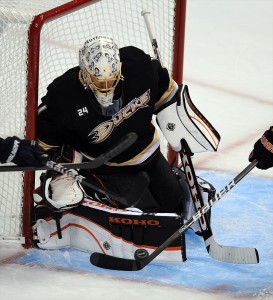
In the Ducks 13 playoff games, they had four goaltending changes mid-game. Four times Jonas Hiller came in off the bench in relief, twice against the Stars and twice against the Kings. The Ducks started out with Frederik Andersen in net against the Stars, but he was pulled after squandering a 2-0 Ducks lead in Game 4, allowing the Stars to win 4-2. Coach Bruce Boudreau gave him a vote of confidence, and started him in Game 5, a 6-2 Anaheim win. However, he was pulled again in Game 6 after allowing 4 goals on 12 shots.
Against the Kings, Hiller was able to earn himself the starting job in the first two games. However, he offered up a lukewarm performance, with a .904 save percentage as the Ducks went down 2-0 to the Kings. In Game 3, the Ducks went back to Frederik Andersen, who was playing well until he got hurt in the third period. Hiller came back in and made 7 saves on 8 shots.
In a surprising move, the Ducks opted to give John Gibson, who had played just 3 NHL games in his career, the start in Game 4. He was tremendous in his first start, a 28 save shutout. That would be the peak of his playoffs, as his save percentage decreased in each subsequent game he started, culminating in a Game 7 loss where he was pulled after allowing 4 goals on 18 shots.
A complete lack of stability in goal was the downfall of the Ducks. Anaheim gave up an average of 2.85 goals per game, a big number considering they were 9th best in the league during the regular season, allowing 2.48 goals per game.
Joe Thornton
The good news for Sharks fans is that when Joe Thornton scored a point in the 2013-14 NHL playoffs, the Sharks won every game. The bad news is that he only had three points, one in each of the Sharks 3 wins that put them up 3-0 on the Kings. Thornton’s performance in the playoffs, or lack thereof, has been a topic of conversation for awhile. Despite being one of the NHL’s premier playmakers over the last 10 seasons, many Sharks fans believe the time has come to trade Jumbo Joe.
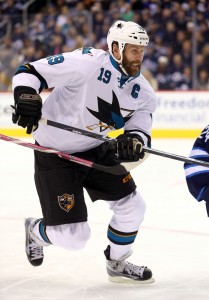
As a player, Thornton’s biggest asset is his vision, composure, and patience with the puck. It’s what makes him a great passer. But in the playoffs, teams have figured out how to stop him. If the opponent plays very tight coverage against Thornton’s wingers, it forces Thornton to shoot the puck, something he hates doing. Despite five top 10 finishes in points, Thornton has scored 30 goals in a season just once in his career. Take away Thornton’s wingers, and you take away his effectiveness.
There have been glimpses of Thornton going into beast mode during the NHL playoffs. He uses his large 6’4″, 220 lb. body to his advantage, going into the hard, dirty areas and asserting his dominance over the game. But, those glimpses have been few and far between. Instead, Thornton has chosen to operate on the perimeter most of the time. Similar to Rick Nash, he seems to lack the drive and desire needed to do what is necessary to win in the NHL playoffs.
Sidney Crosby
In the regular season, Crosby was simply dominant. He finished with 104 points in 80 games, 17 more points than second place Ryan Getzlaf. With Crosby and Malkin on your team, you will always be a threat in the NHL playoffs. The narrative going into the playoffs was that if Marc-Andre Fleury could shake his playoff woes, the Penguins would be one of the favorites.
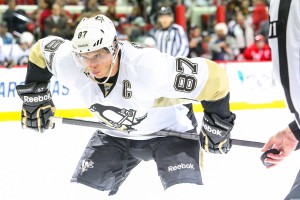
While he was not perfect, Fleury turned in a solid performance in the playoffs. His .915 save percentage was his second best in any playoff, and he broke his streak of four straight postseasons with a save percentage below .900. The narrative of the Penguins’ NHL playoffs ended up being the absence of Crosby from relevance. Dating back to the regular season, Crosby went over 43 periods, the equivalent of 14 and a third games, without a goal.
Crosby finally scores. It had been over 43 straight playoff periods since he last scored.
— Brady Trettenero (@BradyTrett) May 6, 2014
He finally scored in Game 3 against the Rangers, but would go pointless in the final three games of the series as the Penguins fell to the Rangers in 7 games. There was widespread speculation that Crosby was dealing with some type of injury. It has not come out since the Pittsburgh season ended that Crosby has had any type of surgery, so it is possible he may have been dealing with bumps and bruises, and the fatigue of playing 99 games between the NHL and Olympics.
Every player in the playoffs is dealing with some type of slight nagging injury, so unless we hear that Crosby had a major injury, his health is not an excuse. In the playoffs, Crosby appeared to lose a gear in terms of speed, and was not the assertive, dominating offensive force we know. He appeared more passive, not battling hard for pucks in the corners and along the boards. He ended the playoffs with 9 points in 13 games. For almost any other player, that would be an adequate stat line. But for the best player in the world, it wasn’t enough.
Tom
Except Giroux had 6 points in 7 games, hardly a no show
Tom, you know, except for the whole leading his team in points and plus minus…
Bill, you forgot Philly’s finest, Claude Giroux. He was a no show for the entire round 1 series!!
Uhhh, Bill, the second sentence of your article states that the Kings had a “Cinderella cup run in 2010-11”. Actually, the LAK lost in the first round to the Sharks 4 games to 2 that season, and Boston went on to win the Cup that year. LAK had their Cinderella run in 2011-12. Am I wrong to expect better fact checking from a website called thehockeywriters.com?